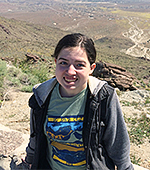The Humanities Institute
Undergraduate Research Fellows 2020-21
BRANDON CASTRO

Film and Digital Media
“Sancho & The School of Quetzalcoatl”
My project is centered on my adoptive family’s relationship to the Brown Berets who were a political group started in the late 1960s by dual Spanish/English language speakers in Los Angeles. They modeled themselves after the Black Panthers and worked alongside other activist groups in protest of the high mortality rate of Latinos and people of color in the Viet Nam War. The project is furthering my education by allowing me to expand my interests in film, moving images, and the use of digital media through exploring the history of my identity and of my adoptive family, specifically my uncle.
LUCY DASILVA

Independent Study
“The Blacklist Revisited: Jewish Screenwriters' Memories of the McCarthy Era”
My project explores the blacklist experiences of three Jewish screenwriters who were active in Hollywood during the 1940s: Spanish Civil War veteran and member of the Hollywood Ten, Alvah Bessie (1904-1985); World War II veteran and New Yorker writer, Walter Bernstein (1919-2021); and, rara avis in the Hollywood of that era, the proto-feminist writer Norma Barzman (b. 1920). After being blacklisted for their Communist affiliations, these three screenwriters were able to continue their creative enterprises in the margins of American society, or in exile from the United States. By closely reading their memoirs in dialogue with each other, I examine the idea of creative resilience in the face of forced alienation, expatriation, and poverty, asking these key questions: how did their Jewish heritage and their commitment to social justice shape their work and their choice of genres? How did these screenwriters triumph over their circumstances? And through what creative means did they do so?
LOGAN FITZSIMONS

Psychology
“Queering the Cowboy”
My project is a study of the true cowboys of the American West, American mythological figures who are less John Wayne and more black and queer buckeroos roaming the plains. My key research question is: to what extent is the true figure lost to the sands of time? In order to answer this question, I am doing both a historical and literary analysis of historical texts, songs, movies, books, contemporary “cowboy” stars in the industry, and I am arguing that the era of the (visibly) queer cowboy is upon us. Many might think of the 2005 film Brokeback Mountain as the pivot-point for the acknowledgement of queer cowboys; however, these vaqueros have been around since the first cattle ranch. The real heroes of the West aren’t the square-jawed white men who we see on posters, lunchboxes, movie reels, and magazines. As such, I am attempting to construct a fuller historical narrative of the true buckaroos of old in order to fully understand the reach of and fascination with this newly exposed phenomenon of the “gay cowboy” and how this figure blends with queer style and pop culture today.
JONAH GERTZ
 Intensive History
Intensive History“The Relationship Between SCAP, the Development of Narcotics Control Laws in Postwar Japan and the ‘Hiropon Age’”
In my project, I argue that Occupation-era narcotics control laws were not effective when first enacted and have distorted modern Japanese policy making. Following defeat in World War II, Japan experienced its first major drug epidemic in the Hiropon Age. Hiropon (a marketable moniker for the substance more commonly known as methamphetamine) was sold from 1941 as a productivity-enhancement drug in pharmacies to the Japanese domestic market. The Japanese military also utilized the drug to keep soldiers, pilots, and industrial workers awake for longer periods of time and to reduce appetite. Accordingly, in the postwar period, there already existed a large base of consistent hiropon consumers. After the infrastructural collapse of the Japanese state in the early postwar era, consumption trends only increased. During the Occupation era (1945-1952), the Supreme Commander for the Allied Powers (or SCAP) implemented sweeping ideological reform to Japanese narcotics control based on existing American policy. However, such reform failed to address the growing hiropon epidemic in favor of controlling substances like marijuana, heroin, opium, and cocaine, which were more of a concern for American legislators than the Japanese general public. Today, many occupation era narcotics control laws are still in effect, despite never having acted as an effective safeguard for public health.
MAYA GONZALEZ

Intensive History
“Remember Us: Holocaust Representation in European-Jewish Émigré Film, 1942-1945”
The Jewish and European émigré directors of wartime America tasked themselves with the difficult mission of warning the public against the Nazi threat to Jewish life in Europe, which was over thirty years before American audiences became familiar with the Holocaust as an historical event. Through historical analysis of the first three Holocaust films and their directors, my project argues that Hollywood failed to provide the promised "essential wartime education" for the American public. Fundamentally, Jewish studio heads and the Production Code Administration stymied efforts by individual European émigré filmmakers to combat American xenophobia and antisemitism in order to remain in control of a studio system that avoided serious consideration of Jewish issues on screen.
SAGE MICHAELS

Intensive History
“Okinawa Memories Initiative Project History Timeline”
This year, I led a team of students in creating an historical timeline for the Okinawa Memories Initiative (OMI). OMI started in 2011 and took off in 2014 when UC Santa Cruz History Professor and OMI Faculty Director, Alan Christy, took a group of students to Okinawa for the first time. OMI’s goals have evolved since its founding and many different people have contributed to the project. I built the timeline to highlight the work OMI has accomplished, and, in doing so, I hope to articulate why this project matters to so many people. The timeline has become a part of OMI’s website where the public can learn more about OMI and Okinawan history and culture. You can read and explore the timeline here: https://okinawamemories.org/project-history/
JACINTO SALZ

Film and Digital Media
“Birthright—A Documentary”
“Birthright Israel” is an educational tourism experience for Jewish young adults around the world created to strengthen global Jewish identity. Due to pro-Israel, anti-Arab sentiments within the US and positive attitudes towards modern Zionism in Jewish youth programs, many young Jews participate in these “Birthright” trips without exposure to Palestinian perspectives. My documentary Birthright aims to give young American Jews a deeper insight into the modern conditions of people's lives in both Israel and Palestine and expose them to perspectives that are omitted from the “Birthright Israel” program.
KELLY SWENSON

Literature
“Fulfilling Prophecies: Towards An Alternate History of Emancipation”
Emancipation continues today to be a largely unfinished project, and my project examines two novels’ attempts to get ever closer to total emancipation. In their re-visitations to the past, Martin R. Delany’s 1859 novel Blake; or, The Huts of America and Pauline Hopkins’s 1902 novel Of One Blood; or, The Hidden Self employ Christianity as a literary tool against bondage by reviving and reworking biblical prophethood and prophecy for purposes of Black liberation. My analysis demonstrates how the repurposing of oppressive systems, like that of mid-nineteenth and early twentieth-century Christianity, and the rewriting of historical narratives functioned to produce an alternate history of emancipation.
JESSICA VALDEZ ALVAREZ

Literature and Spanish Studies
“Art as a Resource for Indigenous Communities during COVID-19”
During the COVID-19 pandemic, many Indigenous communities have suffered disproportionately negative damage. For many in these communities, art has served not only as a survival mechanism but also as a way to heal and connect with their ancestors. Indigenous art is a mode of resistance in a world that does not want to see it, or that has subalternized it in the past and commercialized it in the present. The podcast CO[N]VIDARTE explores the issues of governmental and social negligence of Indigenous communities, and it demonstrates the power of art as a remedy for such negligence, highlights examples of indigenous sovereignty and agency expressed through art, and explores the intentionality of art compared to its consumption.
KARELY VALDEZ LOPEZ

Spanish Studies
“Language and Identity: Heritage Spanish Speakers’ Sense of Identity and Use of Spanish in the U.S.”
My project researches the linguistic abilities of Heritage Spanish Speakers (HSS) in the United States and how speaking Spanish in the U.S. has formed and shaped the identity of these individuals. I examined to what degree HSS doubt or have doubted their identity because they don’t speak Spanish “correctly,” exploring the following questions: does Spanish define a big part of who they are? Has it made them feel like an “outsider” in their own family and culture? How does language affect our identity? Why is it that a language can have such an effect on our identities?

